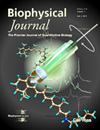登革病毒utr的结构动力学及其环化。
IF 3.1
3区 生物学
Q2 BIOPHYSICS
引用次数: 0
摘要
登革热病毒(DENV)对人类健康构成重大威胁,每年约有4亿人感染。其基因组具有圆形结构,利用位于非翻译区(utr)的环化序列,通过远程RNA-RNA相互作用促进复制。为了进一步了解DENV基因组的组织结构,我们在体外纯化了DENV的5‘和3’ utr,并利用各种生物物理技术结合计算方法检测了它们的结构和结合特性。通过我们的生物物理表征,我们确定了5‘和3’ UTR区域以1:1的化学计量以40 nM的亲和力结合。通过使用小角度x射线散射(SAXS),我们首次提供了3‘和5’ UTR区域的结构表征,揭示了病毒UTR在复制过程中可能采用的几种合理构象。这项全面的研究揭示了在DENV复制过程中提供不同结构状态机制见解的关键特征,通过各种RNA构象的可及性进行追踪。总的来说,我们的研究增强了对DENV环化的理解,强调了这些RNA分子在溶液中的结构适应性、动态折叠和灵活性。通过揭示原子水平上的细节,我们的目标是为开发能够破坏病毒复制关键阶段的靶向药物做出贡献。本文章由计算机程序翻译,如有差异,请以英文原文为准。
Structural Dynamics of Dengue Virus UTRs and Their Cyclization.
The dengue virus (DENV) poses a significant threat to human health, accounting for approximately 400 million infections each year. Its genome features a circular structure that facilitates replication through long-range RNA-RNA interactions, utilizing cyclization sequences located in the untranslated regions (UTRs). To gain new insights into the organization of the DENV genome, we purified the 5' and 3' UTRs of DENV in vitro and examined their structural and binding properties using various biophysical techniques combined with computational methods. Through our biophysical characterization, we determined the 5' and 3' UTR regions to bind with an affinity of 40 nM in a 1:1 stoichiometry. By using small-angle X-ray scattering (SAXS), we provide the first structural characterization of the 3' and 5' UTR regions, revealing several plausible conformations that the viral UTRs may adopt during replication. This comprehensive investigation revealed key features that provide mechanistic insights into the different structural states during DENV replication, as tracked through the accessibility of various RNA conformations. Overall, our research enhances the understanding of DENV cyclization, emphasising the structural adaptability, dynamic folding, and flexibility of these RNA molecules in solution. By uncovering details at the atomic level, we aim to contribute to the development of targeted drugs that can disrupt crucial stages of viral replication.
求助全文
通过发布文献求助,成功后即可免费获取论文全文。
去求助
来源期刊

Biophysical journal
生物-生物物理
CiteScore
6.10
自引率
5.90%
发文量
3090
审稿时长
2 months
期刊介绍:
BJ publishes original articles, letters, and perspectives on important problems in modern biophysics. The papers should be written so as to be of interest to a broad community of biophysicists. BJ welcomes experimental studies that employ quantitative physical approaches for the study of biological systems, including or spanning scales from molecule to whole organism. Experimental studies of a purely descriptive or phenomenological nature, with no theoretical or mechanistic underpinning, are not appropriate for publication in BJ. Theoretical studies should offer new insights into the understanding ofexperimental results or suggest new experimentally testable hypotheses. Articles reporting significant methodological or technological advances, which have potential to open new areas of biophysical investigation, are also suitable for publication in BJ. Papers describing improvements in accuracy or speed of existing methods or extra detail within methods described previously are not suitable for BJ.
 求助内容:
求助内容: 应助结果提醒方式:
应助结果提醒方式:


